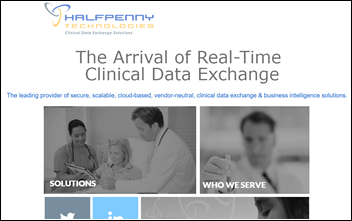Top News

Drug maker Sanofi and Google will establish a virtual innovation lab that will use analytics to understand diseases and to extract patient insights to understand which treatments work best.
Sanofi will also use AI to forecast sales and manage marketing and supply chain efforts and will migrate some of its business applications to Google Cloud.
Paris-based Sanofi, which sells the expensive insulin Lantus, previously formed a join venture with Verily to offer virtual diabetes coaching and tools.
Reader Comments
From Struggling with KLAS: “Re: KLAS doing research on consulting firms. We had been ranked by KLAS for multiple years, but we’re no longer ranked in our category and KLAS can’t get us back up to the minimum number. Our category used to have 35-40 consulting firms ranked and now there are only 11. Has anyone else complained about this? We are seriously considering cancelling our membership. We just aren’t getting value.” I’ll open it up to readers.
From Kloc Programmer: “Re: doctors highlighting EHR data. I don’t get the point. They could miss something by not reading the whole chart. Isn’t all of it important?” Let’s say you’re doing a book report on a 400-page novel. You read / skim with a highlighter in hand, marking the most important points in separating the wheat from the chaff (the author’s job was to write a lengthy book that therefore commands a high price, while yours is to reverse engineer those pages back into an outline of the high points). You write our report and put the book back on your shelf. Two years later, you pick the book back up, and in 60 seconds, you can flip through the pages, read your previously highlighted text and margin notes, and instantly refresh your memory instead of plowing through all 400 pages again. That’s what I’m proposing for an EHR, which intentionally hides the few nuggets a chart contains into volumes of auto-generated and copy-pasted junk. It could work something like this:
- You read through the chart on your first encounter with the patient, marking individual data elements or selected text as useful.
- You add a comment if you like to give yourself a reminder, an explanation, or a question to research later. A margin note, if you will.
- Next visit, you click the magic button that pops up just the information you have marked previously and then highlight anything newly added in the same way.
- Information that no longer seems useful can be banished to the background by unclicking your highlight. That doesn’t affect anyone else and thus doesn’t need rigorous editing.
- Individual highlights or comments can be marked as public or private. Everybody benefits when you flag your item publicly so everybody can see what you found useful, but you can any highlight or comment private.
- The highlighting and review function wouldn’t change the EHR’s functionality. It’s like the annotation feature of Word or of Adobe Acrobat that sits above the hardcore editing tasks.
- Comments could be handwritten via an electronic pen for on-the-fly notation that doesn’t require sitting at a keyboard.
- An even simpler option would be to allow a one-click “I found this useful” marking option to make interesting data elements stand out.
- The rewards for creating note bloat – most of them due to reimbursement or the EHR vendor’s passion for spitting out reams of useless text as a technical parlor trick — aren’t going away soon. At least give doctors a way to mark a chart once and then save time with every visit that follows.
- It’s an EHR win since paper charts offer no way to do this, short of attaching Post-It notes to the front of the manila folder.
- The bottom line is that it’s almost impossible to clean up EHR bloat at this point given the many masters it serves, so we might as well add a smarter, relatively easily implemented layer that makes its contents more useful.
From Right into the Trash: “Re: industry email newsletters. HIStalk I open to click the link. Others I zap unlooked. Am I missing any good ones?” The only one I find useful is Advisory Board’s daily briefing. Others lured me in initially with slick writing that unfortunately went nowhere, while others just blast out time-wasting clickbait links claiming to be “curated” but obviously not by an industry expert. I always tell Mrs. HIStalk that a particular restaurant or retail store has a “high hit rate” a high percentage of choices that I would actually buy and Advisory Board’s daily update has that. I also use my “high hit rate” standard to evaluate health and health IT websites to determine which of them are worth following consistently (spoiler: in my case at least, I haven’t found any).
HIStalk Announcements and Requests

Friday is the first day of summer, so it’s time once again for my annual Summer Doldrums Special on webinars and new sponsorships, wherein I attempt to break through the industry inattentiveness and indecision that is caused by vacations and family activities. Talk to Lorre, who might even offer a little something extra to former sponsors who regret the “former” part. It’s between you and her since I don’t get involved – I have the luxury of being purely the writing, analysis, and snark specialist.
Webinars
July 25 (Thursday) 2:00 ET. “Meeting patient needs across the continuum of care.” Sponsor: Philips Population Health Management. Presenters: Cindy Gaines, chief nursing officer, Philips Population Health Management; Cynthia Burghard, research director of value-based healthcare IT transformation strategies, IDC. Traditional care management approaches are not sufficient to deliver value-based healthcare. Supplementing EHRs with advanced PHM technology and a scalable care management approach gives health systems proactive and longitudinal insights that optimize scarce resources in meeting the needs of multiple types of patients. This webinar will address the key characteristics of a digital platform for value-based care management, cover the planning and deployment of a scalable care management strategy, and review patient experience scenarios for CHF and diabetes.
Previous webinars are on our YouTube channel. Contact Lorre for information.
Acquisitions, Funding, Business, and Stock

Collective Health, which offers a health benefits management system for self-insured employers, raises $205 million in a Series E funding round, increasing its total to $434 million. Co-founder Rajaie Batniji, MD, DPhil (same as a PhD) was until recently a Stanford medical school professor.

Hospital laboratory consulting firm Accumen, which was acquired by a private equity firm in January 2019, acquires clinical data exchange technology vendor Halfpenny Technologies.

Quartet Health, whose technology connects people who have medical conditions with mental health providers when appropriate, raises $60 million in a Series D funding round led by insurer Centene, increasing its total to $153 million. Two of the three co-founders have left their executive positions but remain on the company’s board.

Community-based organization referral platform vendor Aunt Bertha raises $16 million in a Series C funding round. I interviewed CEO Erine Gray last month and reader response was really good.
Sales
- Capital Caring (VA) chooses Netsmart’s MyUnity EHR to enrich person-centered care in hospice and palliative care.
- Community Health Network (IN) will implement MModal’s conversational artificial intelligence to speed up Epic documentation and will also quickly roll out the company’s virtual scribing solution.
People

Justin Box (Mary Washington Healthcare) joins Driscoll Health System (TX) as VP/CIO.

UCSF promotes Rohit Gupta to the newly created position of chief biobank officer, where he will oversee the use of human specimens for research, the creation of consent and processing protocols, and integrating genomic data with the EHR. He worked his way up from his first Stanford job as a clinical study research assistant as he was earning his only academic credential, a bachelor’s degree in biology.
Announcements and Implementations
St. Luke’s Health Care System goes live on Meditech Expense.
Government and Politics
The American Hospital Association wants ONC to restore the requirement that Qualified Health Information Networks support FHIR after it was removed from the second draft of TEFCA (Trusted Exchange Framework and Common Agreement).
Privacy and Security

Hong Kong Hospital Authority admits – after initially denying it — that it gave police a list of people who were treated in its ED after protesting a proposed law that would allow citizens to be extradited to mainland China for trial. The Hospital Authority claims it did not intentionally leak the information, but says that the hospital’s ED computers are always logged in and anyone can access the information it contains. An intercepted email from the Hospital Authority ordered employees to classify each ED patient as police, reporter, civilian, or other, while a hospital doctor publicly showed an EHR screen that was labeled “For Police.”

The computer systems of Olean Medical Group and Seneca Nation Health System (NY) are brought down in ransomware attacks.
Other

Vietnam’s Ministry of Health wants 90% of the population covered by an EHR by 2025, with district-level clinics scheduled for the first round of go-lives next month. The kick-off meeting was held June 14 in Hanoi. Project participants say they are challenged by lack of interoperability and missing connections between practices and hospitals. Hospitals and practices will not be allowed to use paper medical records after 2028.
In Canada, Ottawa Hospital reports 15-deep patient lines at its clinics following its June 1 Epic go-live on because of the time required to re-enter some patient information. Only in a polite country like Canada would the nurse’s union rep decline to rip the hospital when asked about the delays, instead offering the union’s support and remind the reporter that the delays were expected, adding her thought that “hopefully it will get better every day.”
Providence St. Joseph Health EVP/CIO BJ Moore — hired in January 2019 after a 26-year career working for Microsoft — says that Providence St. Joseph and the healthcare industry as a whole are 15-20 years behind in technology. His goals are to simplify the health system’s technology, improve its network performance, speed up employee onboarding, move systems from owned data centers to the cloud, and roll out Epic throughout the system to replace the 14 EHRs that its 51 hospitals use. He also wants to bring more external data into the EHR from consumer wearables.

A one-star rated nursing home in New York is fined $48,000 after its medical director orders insulin over the phone for a resident whose hospital discharge note clearly indicated that she shouldn’t have it. The doctor blamed a nurse who he said didn’t read him the warning correctly, also speculating that the patient was admitted to the hospital in the first place because someone accidentally deleted her blood glucose readings from the EHR.

Industry long-timer and North Carolina FC soccer team owner Steve Malik — who founded Medfusion in 2000 and remains its owner – proposes building a $1.9 billion stadium and multi-used develop in downtown Raleigh, NC to convince Major League Soccer to give the city a team in its expansion.
A Kaiser Health News report observes the sharp increase in the number of hospitals that offer ECMO (extra-corporeal membrane oxygenation), a “very expensive, labor-intensive and unsuccessful effort to cheat death” that creates cost and ethical dilemmas in keeping patients whose hearts and lungs don’t work alive even though few of them ever leave the ICU. It also forces family members to choose the moment at which it will be turned off, for which experts urge having the doctor set the date instead. A Brigham doctor concludes that ECMO is a great example of “just because you can doesn’t mean you should.”
Only in healthcare: a hacker who installed ransomware in the computer systems of an Ohio urology practice sends their $75,000 ransom demand (which was paid) via the office’s fax machine.
Sponsor Updates
- The Omni-HealthData analytics platform from Information Builders is named Best Overall Healthcare Data Analytics Platform in the 2019 MedTech Breakthrough Awards program.
- Audacious Inquiry will offer users of its Encounter Notification Service the ability to share their data with CarePort Health for care coordination.
- Location technology powered advertising platform Brandify will offer health system marketing programs a consumer-facing “providers near me” option, presenting optimized provider and location data from Kyruus.
- Aprima will exhibit at HFMA June 23-26 in Orlando.
- CoverMyMeds will exhibit at the EMDs 2019 User Conference & Symposium June 20-22 in Austin, TX.
- ACAP selects Cumberland Consulting Group as a preferred vendor for consulting services.
Blog Posts

Contacts
Mr. H, Lorre, Jenn, Dr. Jayne.
Get HIStalk updates. Send news or rumors.
Contact us.




















































































That, or we see if Judy will announce Epic's new Aviation module (probably called Kitty Hawk) that has integrated Cruise…